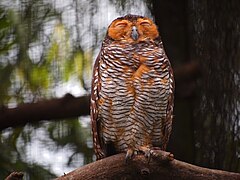The spotted wood owl (Strix seloputo) is an owl of the earless owl genus, Strix. Its range is disjunct; it occurs in many regions surrounding Borneo, but not on that island itself.
| Spotted wood owl | |
|---|---|

| |
| Pasir Ris Park, Singapore | |
| Scientific classification | |
| Domain: | Eukaryota |
| Kingdom: | Animalia |
| Phylum: | Chordata |
| Class: | Aves |
| Order: | Strigiformes |
| Family: | Strigidae |
| Genus: | Strix |
| Species: | S. seloputo
|
| Binomial name | |
| Strix seloputo Horsfield, 1821
| |
| Synonyms | |
| |

Description
editThe spotted wood owl grows to a length of about 44 to 48 cm (17 to 19 in) with a wing length of 30 to 36 cm (12 to 14 in). The head is chocolate brown with an orangish-buff facial disc and, in the nominate subspecies, a yellowish throat band, but there are no ear-tufts. The upper parts are coffee-coloured, with white bars and spots edged with black. The underparts are dull yellow with broad white and narrow black bars. The eye is dark brown and the beak greenish-black. The legs and toes are well-feathered, with the visible parts being olive. The call is a rolling "huhuhu" followed by a long "whoo".[3]
Distribution and habitat
editThere are three subspecies: Strix seloputo seloputo occurs in South Myanmar and central Thailand to Singapore as well as Jambi (Sumatra) and Java; Strix seloputo baweana is endemic to the island of Bawean off North Java; Strix seloputo wiepkini occurs in the Calamian Islands and Palawan (Philippines). Typical habitats include lowland forest, mangrove swamps, cleared woodland, plantations, and parks in towns and villages.[3]
Ecology
editThe diet of this owl consists mainly of mice and rats, supplemented by insects and small birds.[3]
Status
editThe spotted wood owl has a very wide range, and is described as being common in some areas. The population size has not been quantified but it seems to be stable, and the International Union for Conservation of Nature has assessed the bird's conservation status as being of "least concern".[1]
References
edit- ^ a b BirdLife International (2016). "Strix seloputo". IUCN Red List of Threatened Species. 2016: e.T22689061A93216609. doi:10.2305/IUCN.UK.2016-3.RLTS.T22689061A93216609.en. Retrieved 12 November 2021.
- ^ "Appendices | CITES". cites.org. Retrieved 2022-01-14.
- ^ a b c Mikkola, Heimo (2017). Owls of the World - A Photographic Guide. Bloomsbury Publishing. p. 322. ISBN 978-1-4729-4561-7.
- Holt, Denver W., Berkley, Regan; Deppe, Caroline; Enríquez Rocha, Paula L.; Olsen, Penny D.; Petersen, Julie L.; Rangel Salazar, José Luis; Segars, Kelley P. & Wood, Kristin L. (1999): 94. Spotted Wood Owl. In: del Hoyo, J.; Elliott, A. & Sargatal, J. (eds): Handbook of Birds of the World, Volume 5: Barn-owls to Hummingbirds: 197, plate 12. Lynx Edicions, Barcelona. ISBN 84-87334-25-3
- König, Claus; Weick, Friedhelm & Becking, Jan-Hendrik (1999): Owls: A guide to the owls of the world. Yale University Press, New Haven. ISBN 0-300-07920-6
- Lewis, Deane P. (2005): OwlPages.com Owl Species ID: 130.010.000 - Spotted Wood Owl - Strix seloputo. Version of 2005-APR-21. Retrieved 2007-AUG-16.
External links
edit- Media related to Strix seloputo at Wikimedia Commons
